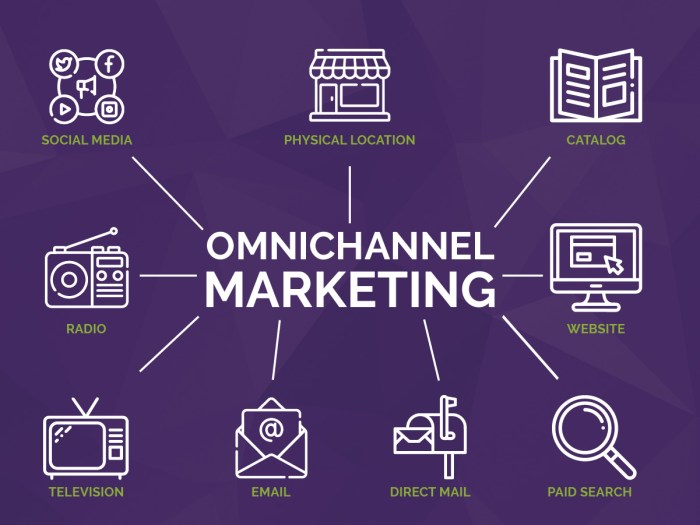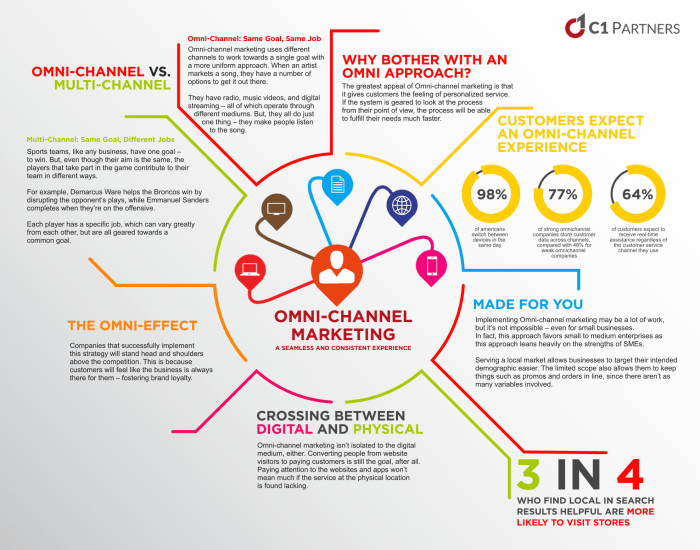With Developing an Omnichannel Marketing Strategy at the forefront, this paragraph opens a window to an amazing start and intrigue, inviting readers to embark on a storytelling journey filled with unexpected twists and insights. Omnichannel marketing is the new wave, and it’s time to ride it to success!
In today’s digital age, having a seamless strategy that encompasses all channels is crucial for businesses to connect with their audience effectively. Let’s dive deep into the world of omnichannel marketing and uncover the secrets to crafting a winning strategy.
Understanding Omnichannel Marketing: Developing An Omnichannel Marketing Strategy
Omnichannel marketing is a strategy that focuses on providing a seamless and integrated shopping experience for customers across multiple channels, both online and offline. This approach allows customers to interact with a brand through various touchpoints such as websites, social media, mobile apps, physical stores, and more. In today’s digital landscape, where consumers expect personalized and consistent interactions with brands, omnichannel marketing plays a crucial role in engaging customers and driving sales.
Differences between Omnichannel and Multichannel Marketing
- Omnichannel marketing provides a unified and cohesive experience across all channels, ensuring consistency in messaging and branding. On the other hand, multichannel marketing involves using multiple channels to reach customers but may lack integration and consistency.
- With omnichannel marketing, customer data is shared and utilized across all channels to create a personalized experience. In contrast, multichannel marketing may treat each channel separately, leading to fragmented customer interactions.
- Omnichannel marketing focuses on the customer journey as a whole, from awareness to purchase and beyond, while multichannel marketing may only focus on individual touchpoints.
Examples of Successful Omnichannel Marketing Strategies
- Apple: Apple seamlessly integrates its online store, physical retail locations, and mobile app to provide a consistent shopping experience for customers. Customers can research products online, visit a store to try them out, and make a purchase through the app or website.
- Starbucks: Starbucks’ mobile app allows customers to order ahead, pay, and earn rewards, creating a seamless experience across their website, app, and physical stores. The app also collects data on customer preferences to provide personalized recommendations.
- Nike: Nike’s omnichannel strategy includes a strong online presence, physical stores, and partnerships with retailers. Customers can shop online, visit a store for customization or product pickup, and engage with the brand through social media and events.
Key Elements of Developing an Omnichannel Strategy
When it comes to developing an omnichannel strategy, there are key elements that play a crucial role in its success. Consistency across all channels, the use of data analytics for personalized experiences, and the integration of online and offline channels are some of the essential components to consider.
Consistency Across All Channels
- Consistency in messaging, branding, and customer experience helps in creating a seamless journey for customers across all channels.
- It builds trust and loyalty among customers, as they receive a unified experience, no matter which channel they interact with.
- Consistency also helps in reinforcing brand identity and values, making it easier for customers to recognize and engage with the brand.
Data Analytics for Personalized Experiences
- Data analytics play a critical role in understanding customer behavior, preferences, and purchase patterns.
- By analyzing data, businesses can create personalized recommendations, offers, and communications tailored to each customer’s needs and interests.
- Personalization enhances the overall customer experience, leading to increased engagement, satisfaction, and ultimately, higher conversion rates.
Integration of Online and Offline Channels
- Integrating online and offline channels allows customers to move seamlessly between digital and physical touchpoints.
- It provides a holistic view of the customer journey, enabling businesses to deliver a consistent experience regardless of the channel used.
- By connecting online and offline interactions, businesses can enhance customer engagement, drive foot traffic to stores, and increase online sales.
Implementing Technology in Omnichannel Marketing

Implementing technology plays a crucial role in executing a successful omnichannel marketing strategy. By leveraging various tools and platforms, businesses can streamline their operations, enhance customer experiences, and drive sales. Let’s delve into the key aspects of implementing technology in omnichannel marketing.
Utilizing CRM Systems, AI, and Automation Tools
Integrating Customer Relationship Management (CRM) systems, Artificial Intelligence (AI), and automation tools can help businesses effectively manage customer interactions across multiple channels. CRM systems enable companies to track customer data, preferences, and interactions, allowing for personalized marketing campaigns and targeted messaging.
- AI-powered tools can analyze customer behavior, predict trends, and optimize marketing strategies for better engagement and conversion rates.
- Automation tools streamline processes, such as email marketing, social media posting, and customer service responses, ensuring consistency and efficiency across channels.
The Benefits of Using a Customer Data Platform (CDP)
A Customer Data Platform (CDP) serves as a centralized hub for collecting, organizing, and analyzing customer data from various sources. By integrating data from multiple touchpoints, businesses can gain a comprehensive view of their customers’ preferences, behaviors, and purchase history.
- With a CDP, companies can create targeted marketing campaigns, deliver personalized content, and optimize customer engagement based on real-time insights.
- Improved data accuracy and consistency lead to better decision-making, more effective cross-selling opportunities, and enhanced customer loyalty.
Challenges in Integrating Different Technologies
While implementing various technologies in an omnichannel strategy offers numerous benefits, businesses may encounter challenges in integrating these tools seamlessly.
- Compatibility issues between different systems and platforms can lead to data silos, inconsistent customer experiences, and inefficiencies in marketing operations.
- Ensuring data security and compliance with regulations becomes crucial when handling sensitive customer information across multiple channels and tools.
- Training employees to use new technologies effectively, optimizing processes, and adapting to evolving consumer preferences are ongoing challenges in maintaining a successful omnichannel strategy.
Measuring Success in Omnichannel Marketing

In the world of omnichannel marketing, it is crucial for businesses to effectively measure the success of their strategies. By tracking key performance indicators (KPIs) and customer journey metrics, businesses can optimize their campaigns and drive better results.
Key Performance Indicators (KPIs)
- Conversion Rate: This metric helps businesses understand how many customers are taking the desired action, such as making a purchase, across different channels.
- Customer Lifetime Value (CLV): CLV measures the total revenue a business can expect from a customer throughout their entire relationship. It helps in evaluating the long-term success of omnichannel efforts.
- Customer Retention Rate: This KPI indicates the percentage of customers that continue to engage with the brand over time. It is essential for measuring the effectiveness of omnichannel strategies in building customer loyalty.
Importance of Tracking Customer Journey Metrics, Developing an Omnichannel Marketing Strategy
Understanding the customer journey across various touchpoints is essential for optimizing omnichannel campaigns. By tracking metrics like time spent on each channel, interactions, and preferences, businesses can tailor their marketing efforts to better meet customer needs and improve overall engagement.
Tools and Analytics Platforms
- Google Analytics: A widely-used tool that provides detailed insights into website traffic, user behavior, and conversion rates across different channels.
- Adobe Analytics: Offers advanced analytics capabilities to track customer interactions, segment data, and measure the impact of omnichannel campaigns.
- HubSpot: A comprehensive marketing platform that enables businesses to analyze performance metrics, track customer journeys, and optimize omnichannel strategies for better results.
